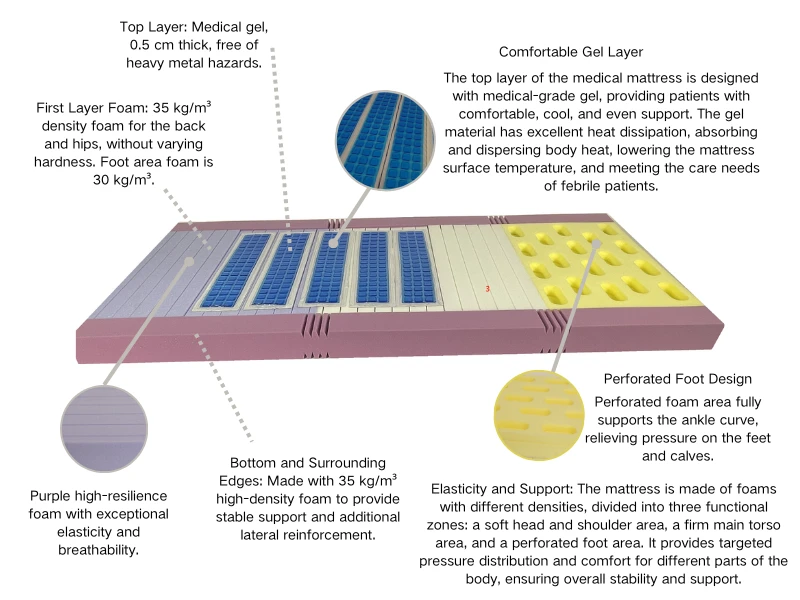Effective Mattress Solutions for Preventing Pressure Ulcers and Enhancing Patient Comfort
An Overview of Pressure Ulcer Prevention Mattresses
Pressure ulcers, also known as bedsores or decubitus ulcers, are localized injuries to the skin and underlying tissue that occur due to prolonged pressure, typically over bony areas of the body. They present a significant challenge in healthcare, especially for individuals with limited mobility. The implications of pressure ulcers extend beyond physical discomfort; they can lead to serious complications and increased healthcare costs. One of the key strategies for preventing these injuries is the use of specialized mattresses designed to alleviate pressure on vulnerable areas. This article provides an overview of pressure ulcer prevention mattresses, the different types available, and their importance in care settings.
Understanding Pressure Ulcers
The development of pressure ulcers can occur in various settings, including hospitals, long-term care facilities, and even at home. Factors that contribute to their formation include immobility, incontinence, malnutrition, and moisture, among others. The severity of pressure ulcers is classified into stages, varying from Stage I (redness of the skin) to Stage IV (full-thickness skin loss). Prevention is critical, as even mild ulcers can lead to severe pain, infections, and longer hospital stays.
The Role of Prevention Mattresses
Pressure ulcer prevention mattresses are specifically designed to redistribute pressure on the body's surface to reduce the risk of skin breakdown. They come in various types, each offering unique benefits that can cater to different patient needs. The goal of these mattresses is to maintain blood flow to vulnerable areas, thereby enhancing skin integrity and overall comfort.
Types of Pressure Ulcer Prevention Mattresses
1. Foam Mattresses These are one of the most commonly used types of prevention mattresses. They feature high-density foam that conforms to the body’s shape and offers adequate support. Foam mattresses are lightweight, cost-effective, and provide good pressure relief.
2. Alternating Pressure Mattresses These mattresses use air cells that alternately inflate and deflate, creating a dynamic support system that shifts pressure points continuously. This action helps to enhance blood flow and reduce the risk of pressure injuries, making them highly effective for high-risk patients.
pressure ulcer prevention mattress

3. Low-Air-Loss Mattresses Equipped with air chambers, these mattresses can maintain a specified level of air pressure and promote moisture management. Low-air-loss mattresses help keep the skin dry, reducing friction and shear forces that can lead to skin breakdown.
4. Gel and Hybrid Mattresses Gel mattresses combine the benefits of foam and gel materials, offering enhanced pressure relief and cooling properties. Hybrid mattresses often incorporate multiple technologies to maximize comfort and prevention.
5. Lateral Rotation Mattresses These are designed to tilt patients gently from side to side, promoting movement while distributing pressure more evenly. This reduces the time spent in one position and helps ward off potential sores.
Importance in Patient Care
The implementation of pressure ulcer prevention mattresses is vital in various care settings. They not only contribute to patient comfort but also play a critical role in reducing healthcare costs associated with the treatment of pressure ulcers. By preventing skin breakdown, healthcare providers can improve patient outcomes, reduce hospital stay durations, and enhance the overall quality of care.
Furthermore, alongside the use of specialized mattresses, it is essential to incorporate a comprehensive care plan that includes regular repositioning, skin assessments, nutritional support, and patient education. Training caregivers on the proper use of these mattresses can also ensure optimal effectiveness.
Conclusion
Pressure ulcer prevention mattresses are a crucial element in the fight against pressure injuries in vulnerable populations. By understanding the different types of mattresses available and their respective benefits, healthcare providers can make informed decisions on the best options for their patients. The integration of these mattresses into patient care not only protects skin integrity but also enhances the overall well-being of individuals at risk of developing pressure ulcers. Investing in such preventive measures is a testament to the commitment of healthcare providers to prioritize patient safety and comfort, ultimately leading to improved health outcomes.
-
Mattresses Designed for Back Pain ReliefNewsAug.08,2025
-
Innovative Wave Mattresses for Ultimate ComfortNewsAug.08,2025
-
High-Quality Mattresses for Hospital BedsNewsAug.08,2025
-
High-Quality Mattresses for Every NeedNewsAug.08,2025
-
Healthcare Foam Mattress: Sleep Better, Heal FasterNewsAug.08,2025
-
Cube Mattress for Daily ComfortNewsAug.08,2025
-
How Hospital Mattress Choices Directly Impact Patient Comfort and CareNewsAug.05,2025

